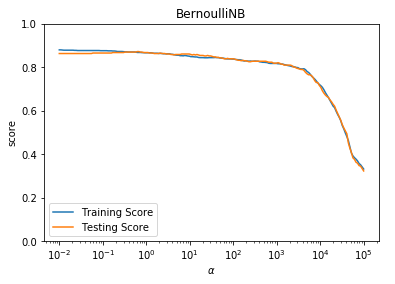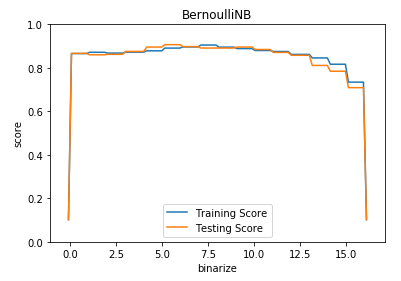import numpy as np import matplotlib.pyplot as plt from sklearn import datasets,naive_bayes from sklearn.model_selection import train_test_split # 加载 scikit-learn 自带的 digits 数据集 def load_data(): ''' 加载用于分类问题的数据集。这里使用 scikit-learn 自带的 digits 数据集 ''' digits=datasets.load_digits() return train_test_split(digits.data,digits.target,test_size=0.25,random_state=0,stratify=digits.target) #伯努利贝叶斯BernoulliNB模型 def test_BernoulliNB(*data): X_train,X_test,y_train,y_test=data cls=naive_bayes.BernoulliNB() cls.fit(X_train,y_train) print('Training Score: %.2f' % cls.score(X_train,y_train)) print('Testing Score: %.2f' % cls.score(X_test, y_test)) # 产生用于分类问题的数据集 X_train,X_test,y_train,y_test=load_data() # 调用 test_BernoulliNB test_BernoulliNB(X_train,X_test,y_train,y_test)

def test_BernoulliNB_alpha(*data): ''' 测试 BernoulliNB 的预测性能随 alpha 参数的影响 ''' X_train,X_test,y_train,y_test=data alphas=np.logspace(-2,5,num=200) train_scores=[] test_scores=[] for alpha in alphas: cls=naive_bayes.BernoulliNB(alpha=alpha) cls.fit(X_train,y_train) train_scores.append(cls.score(X_train,y_train)) test_scores.append(cls.score(X_test, y_test)) ## 绘图 fig=plt.figure() ax=fig.add_subplot(1,1,1) ax.plot(alphas,train_scores,label="Training Score") ax.plot(alphas,test_scores,label="Testing Score") ax.set_xlabel(r"$alpha$") ax.set_ylabel("score") ax.set_ylim(0,1.0) ax.set_title("BernoulliNB") ax.set_xscale("log") ax.legend(loc="best") plt.show() # 调用 test_BernoulliNB_alpha test_BernoulliNB_alpha(X_train,X_test,y_train,y_test)

def test_BernoulliNB_binarize(*data): ''' 测试 BernoulliNB 的预测性能随 binarize 参数的影响 ''' X_train,X_test,y_train,y_test=data min_x=min(np.min(X_train.ravel()),np.min(X_test.ravel()))-0.1 max_x=max(np.max(X_train.ravel()),np.max(X_test.ravel()))+0.1 binarizes=np.linspace(min_x,max_x,endpoint=True,num=100) train_scores=[] test_scores=[] for binarize in binarizes: cls=naive_bayes.BernoulliNB(binarize=binarize) cls.fit(X_train,y_train) train_scores.append(cls.score(X_train,y_train)) test_scores.append(cls.score(X_test, y_test)) ## 绘图 fig=plt.figure() ax=fig.add_subplot(1,1,1) ax.plot(binarizes,train_scores,label="Training Score") ax.plot(binarizes,test_scores,label="Testing Score") ax.set_xlabel("binarize") ax.set_ylabel("score") ax.set_ylim(0,1.0) ax.set_xlim(min_x-1,max_x+1) ax.set_title("BernoulliNB") ax.legend(loc="best") plt.show() # 调用 test_BernoulliNB_binarize test_BernoulliNB_binarize(X_train,X_test,y_train,y_test)
